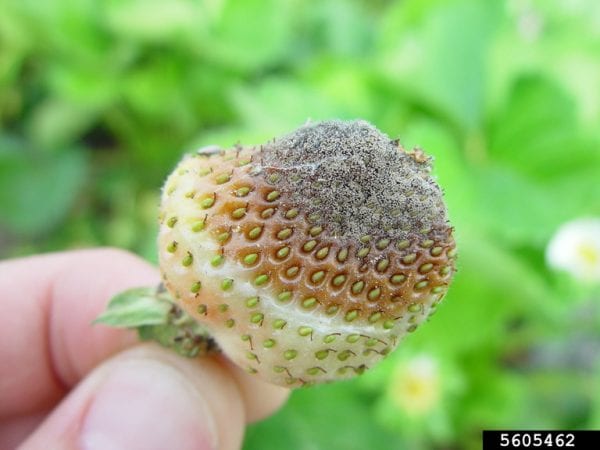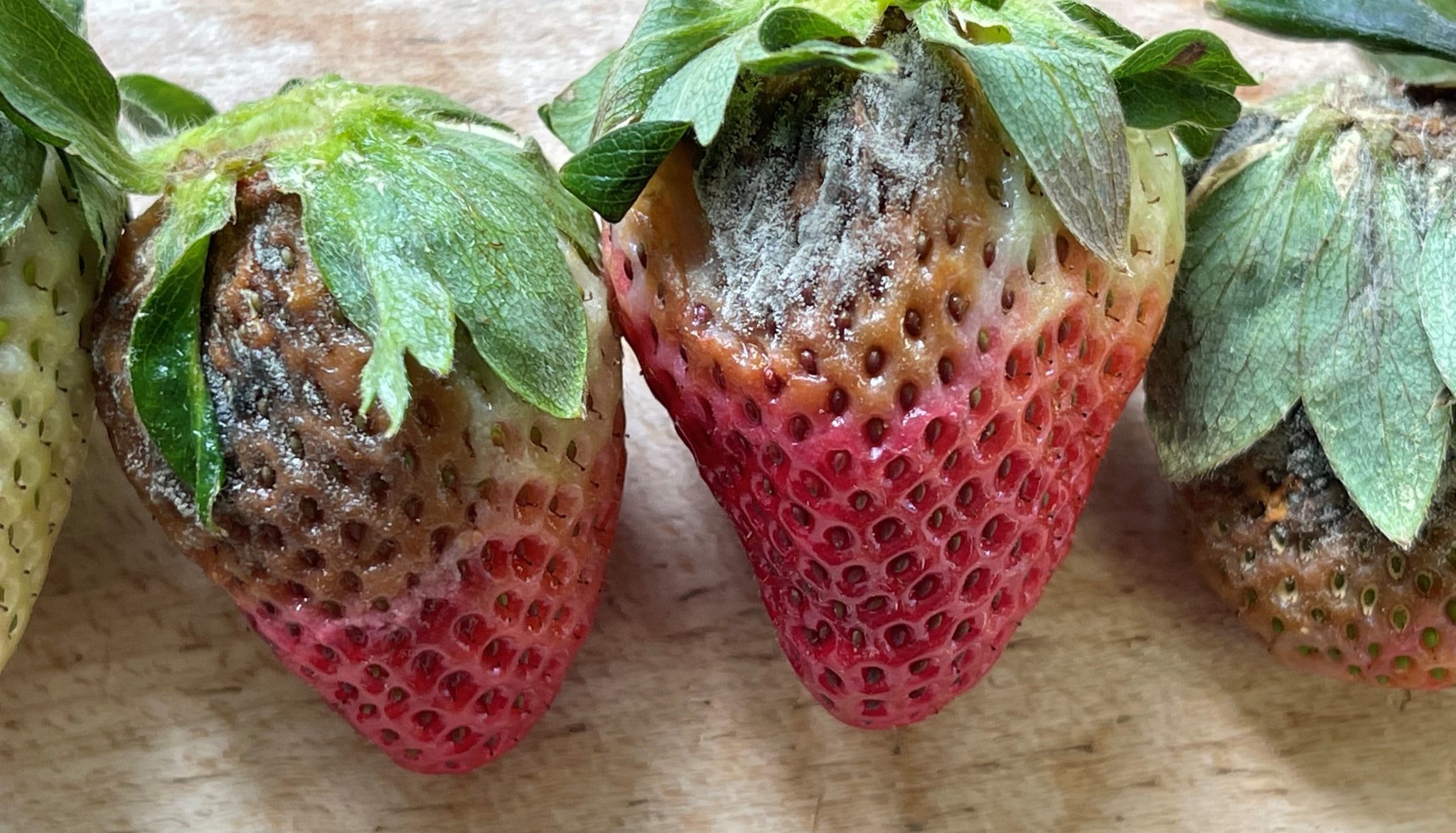Crop Production

Gray mold (also known as Botrytis blight or Botrytis fruit rot) is one of the more common diseases affecting strawberries. The disease, caused by the fungus Botrytis cinerea, can cause millions of dollars in lost revenue to the strawberry industry if not properly managed.
Gray mold can affect leaves, stems, flowers, and crowns of strawberry. The disease can be difficult to manage due to its wide host range and its ability to over-winter as sclerotia (hardened fungal mycelium) in an infested field. Infected plant tissue becomes necrotic and will be covered with masses of gray fungal spores.
Symptoms

Figure 1. Gray mold on green strawberry. Photo by Gerald Holmes, Strawberry Center, Cal Poly San Luis Obispo, Bugwood.org.
The most common symptom of gray mold is fruit rot. A light gray or brownish lesion will develop near the stem end of the fruit. In time, a grayish, fuzzy mass of spores will spread over the lesion as well as cover the entire fruit. Lesions can be found on green fruit as well as ripening fruit (Figure 1). Gray mold can also cause a post-harvest rot, developing on the fruit after harvest while in storage.
Disease Cycle
Botrytis can be introduced into a field on infected transplants or can survive on dead plant material and in soil in the form of sclerotia. When conditions are favorable in late winter or early spring, the fungus begins to grow and produce spores. The spores can be spread throughout the planting by wind and wind-blown rain. Field workers and pickers can also spread the pathogen on their hands, clothes, or shoes during harvest. The pathogen thrives in cool, humid conditions (65°F-75°F).
Management
- Begin with healthy transplants. Be sure to acquire plants from a reputable nursery. Often, diseases such as gray mold will be present on plants at the nursery. Be sure that your plants are certified disease-free.
- Use sanitation. Scout the field and remove dead and infected plant material to reduce the population of the pathogen. Bag infected plant material in the field to avoid further spread. If there are localized areas of infection or ‘hot spots,’ remove and destroy (burn) all infected plants. Harvest all known areas of infection last to minimize spread of the disease within a planting.
- Allow sufficient spacing between plants. This will allow for good airflow through the canopy and quicken drying of foliage and fruit.
- Avoid over-fertilization. Excess nitrogen has been shown to increase fruit rot when weather conditions are favorable for disease development. Schedule fertilizer programs according to leaf tissue nutrient analysis reports.
- Early and regular sprays. Begin your fungicide spray program early and follow the manufacturers’ label directions. The Southeastern Regional Strawberry Integrated Pest Management Guide for Plasticulture Production developed by experts at the Southern Region Small Fruit Consortium (SRSFC) can be found online by visiting https://smallfruits.org/files/2019/06/StrawberryIPMGuide.pdf .
- Use crop rotation. Placing strawberries in a rotation with other crops for two to three years will help reduce the disease in a field.
- Consider harvesting when conditions are dry. Though not always practical, harvesting the patch when dry will minimize the spread of the pathogen.
- Consider using a pre-plant dip. Certain fungicides such as Switch can be used as plant dip to reduce the incidence of gray mold. Prior to planting, plants should be submerged in the dip for at least two minutes. See Table 1 for more information on the use of Switch as a pre-plant; the table is an excerpt from the label (the mention of a product name is for example purposes only).
Table 1. Pre-Plant Measures to Control Gray Mold in Strawberries
| Crop | Disease | Product Rate (oz./Acre) | Remarks |
|---|---|---|---|
| Strawberry and Berry, Low Growing Subgroup 13-07G (except Cranberry) | Botryis cinerea (gray mold) | 5-8 oz. per 100 gal water | Apply as a preplant dip to strawberry roots and crowns at the rate of 5 to 8 oz. per 100 gallons of water for suppression of root and crown rot caused by anthracnose. Wash transplants to remove excess soil prior to dipping. Completely immerse planting stock in dip solution. Dip or expose plants for a minimum of 2 minutes or a maximum of 5 minutes. Completely drain the transplants after dip. DO NOT reuse solution. Dispose of dip solution according to local regulations. |
| Strawberry and cultivars and/or hybrids of these | Botryis cinerea (gray mold) | 5-8 oz. per 100 gal water | Plant treated plants as quickly as possible. For continued anthracnose control, follow with foliar applications beginning 2-3 weeks after transplanting. |
Trade names are used only to give specific information. The Alabama Cooperative Extension System does not endorse or guarantee any product and does not recommend one product instead of another that might be similar.

